
Case Report
J Dent & Oral Disord. 2018; 4(1): 1083.
Chronic Pain: Multiprofessional Case Report – New Vision
Prada SG¹ and Chilvarquer I²*
¹Private clinic, São Paulo, Brazil
²Radiology Department, Faculty of Dentistry, University of São Paulo, Brazil
*Corresponding author: Chilvarquer I, Radiology Department, Faculty of Dentistry, University of São Paulo São Paulo, Brazil
Received: December 12, 2017; Accepted: January 30, 2018; Published: February 06, 2018
Abstract
Objective: We present a case of chronic pain with multiprofessional treatment (new vision).
A female patient presented with chronic migraine, myofascial pain with referred pain, muscular and articular TMD, facial asymmetry, joint hypermobility and rebound head, neck and right shoulder blade pain, which have persisted for three years since an accident (whiplash syndrome).The patient is under hormonal control with an intrauterine device. The teeth, Temporomandibular Joint (TMJ) and neuromuscular system were harmonized with occlusal splint therapy (24 hours). A stable mandibular head position was obtained (disc recapture). Orthopedic misalignment (tilted occlusion and pelvis) was treated with rehabilitation and therapeutic insoles, respectively, which controlled body pain. Conclusion: Some cases of myofascial pain and temporomandibular disorder respond favorably to occlusal splint therapy. The patient experienced a better quality of life, almost without pain, for two years and nine months after treatment, although during the last four months, the patient experienced symptoms of depression and anxiety. The Diagnostic Criteria for Temporomandibular Disorders Research (DC/TMD) Axis I, Patient Health Questionnaire-4 (PHQ-4), Graded Chronic Pain Scale (GCPS), and temporomandibular joint resonance were assessed before and after treatment.
Keywords: Chronic pain; Orofacial pain; Quality of life; Neck pain; Temporomandibular joint
Abbreviations
TMD: Temporomandibular Dysfunction; TMJ: Temporomandibular Joint; PHQ-4: Patient Questionnaire-4; DC/ TMD axis 1: Temporomandibular Dysfunction Research Diagnostic Criteria; GCPS: Graded Chronic Pain Scale; CR: Centric Relation; MIC: Habitual Maximum Intercuspation; HPI: Mandibular Head Axis Position Indicator; IUD: Intrauterine Device; VAS: Visual Analog Scale; DDC: Disc Displacement with Reduction; DDSR: Disc Displacement without Reduction.
Case Presentation
Clinical record (Figure 1)
DC/TMD axis I [1] pressure upon muscular palpation of 1kg for 5 seconds, [2-4] with a VAS [5] scale from 0 (no pain) to 10 (maximum pain) (Figure 2). DC/TMD (Figure 3).
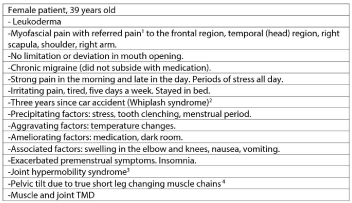
Figure 1: Clinical record.
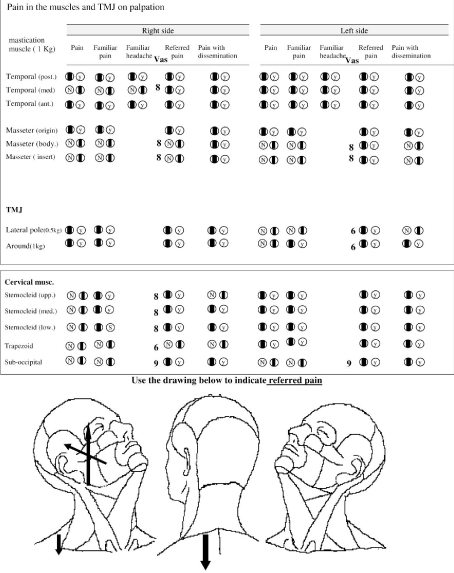
Figure 2: Pain in the muscles and TMJ on palpation, VAS, with illustrative
drawing of referred pain areas.
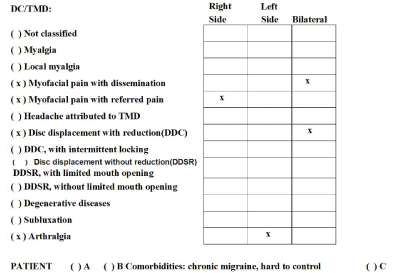
Figure 3: DC l TMD- Diagnosis.
PHQ-4 [6] score of 9 (severe psychological distress), [6] GCPS [7]-Grade 3 pain severity with a high degree of disability, moderately limiting. No systemic diseases.
Evolution of occlusion (Figure 4)
Maximum opening
1. 55 mm, right and left laterality of 10 mm, maximum protrusion of 7 mm.
2. Unstable orthopedic occlusion (discrepancy between CR and MIC). Facial asymmetry (Figure 5). 1-Right eye higher and set back. 2- Right ear higher and set back. 3- Jaw asymmetry.
3. During the final admission, the patient wore a splint and removed it to eat. The patient felt improvement without the need for pain relief. Jaw deprogramming therapy was sought to establish orthopedic stability.
4. Magnetic Resonance Imaging on 2/26/2013 reformatted at T1, right TMJ, on the MIC showed an articular disc translocated toward the anterior pole, and in the open mouth, an instantaneous rotation axis position consistent with normality. Left TMJ, an articular disc with anterior movement (closed mouth) and a reduction in the instantaneous rotation axis maximum opening ( Figure 6, line 0) [8].
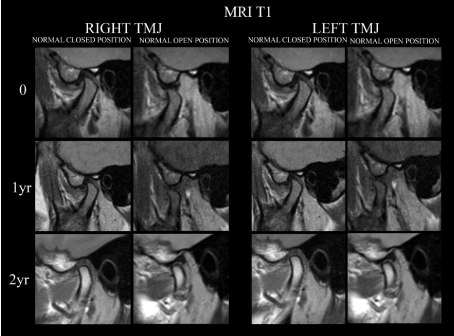
Figure 6: Line 0-Initial Right and Left TMJ resonance in closed and open
mouth positions in T1. Line 1 yr -Right and Left TMJ resonance at T1, in
closed and open mouth positions during treatment (18 months of treatment).
Line 2yr- Right and Left TMJ resonance in T1, mouth closed and open, posttreatment
(seven months after treatment).
5. TMJs and muscles in both assisted and non-assisted maximum opening, protrusive movements and laterality were without pain and without mouth locking. A provocation test (articular test) was positive for the right side (positive counter-test) and negative on the left [9].
Treatment
1. IUD with hormonal control.
2. Mounting of a Panadent articulator, semi-adjustable (Panadent Corp, San Bernardino, California, USA). CR registration with blue wax, DeLar Bite-Registration wax (DeLar Corp, Lake Oswego, Oregon, USA) in two stages [10]. MIC was recorded with Moyco extra-hard pink wax, Moyco Wax (Moyco Inc., Philadelphia, Pennsylvania, USA).
3. After nine months of continuous, 24-hour splint use, including during eating, with periodic adjustments to maintain simultaneous bilateral and anterior contacts, smooth and polished surfaces and protrusive and canine guides. The Bausch BK 28 (Bausch Articulating Papers Inc., Nashua, New Hampshire, USA) carbon contacts were checked. When these contacts remained stable for one month (with the mandibular head position remaining stable for four consecutive weeks, as demonstrated by an HPI instrument (Panadent Corp, San Bernardino, California, USA),10 the mandibular head was seated, leaving only the incisors in contact with the splint, until return without posterior disclusion. The initial pattern of contacts with the splint returned [10]. Now: Overjet = 4 mm, Class I molar, with first contact on the second upper right molar. Overbite = -3 mm (open bite), without protrusive and canine guides. (Figure 4, with HPI).
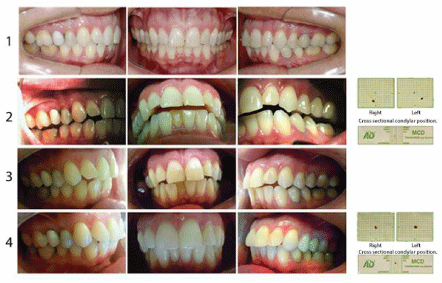
Figure 4: Evolution of occlusion. Line 1: initial. Line 2: after deprogramming
with a splint and with a mandibular Head Axis Position Indicator (HPI). Line 3:
after coronoplasty. Line 4: final after rehabilitation- final HPI.
4. Therapeutic insole 11 to correct for a tilted pelvis. Pain control with auriculo medicine (Nogier). [4].
5. Now virtually no pain (VAS - 1) [5] in the body.
6. Occlusal correction after coronoplasty on models (Figure 7), mounted on the articulator with axiography (true jaw rotation axis transferred to the articulator).Registration was performed with Moyco extra-hard pink wax at four different vertical heights, which were used to confirm the true jaw rotation axis. Resin was added and dental material was removed (clinical coronoplasty) for functional occlusion, leaving the mandibular head seated on the articular fossa and maintaining a stable relationship between the mandibular head and the disc [10]. (Figure 4). The jaw was shifted to the left. After rehabilitation, splint use (24 hours) continued for three weeks, removing occlusion interference for each subsequent week, with new mountings and axiography [10]. An anterior ramp with blue wax directed the adjustments (Figure 4, CR = MIC by HPI). Now: maximum opening of -42 mm, right and left laterality of -8 mm, maximum protrusion of 7 mm.

Figure 7: Coronoplasty on upper and lower models (showing areas of wear).
7. Resonance imaging during treatment (Figure 6, line 1 year).
Post treatment control
MRI imaging on 7/21/2015 reformatted in T1, right TMJ, articular disc position compatible with normality, with remodeling of the articular surfaces and subtle planing of the upper articular surface. Left TMJ (Figure 6, 2 year), articular disc position compatible with normality. Note the subtle displacement of the long axis of the mandibular head toward the anterior pole, remodeling of articular surfaces demonstrating the i maging aspect of articular disc recapture and maintenance of the more physiological position of the articular structures. Over the last four months, the patient had a PHQ-46 (anxiety and depression) score of 9 (12 kg overweight) but maintained pain control (GCPS7 - Grade 1). The patient experienced a better quality of life and a DC/TMD- axis of 1 without pain upon palpation, without deviations and without muscle or TMJ pain during jaw movements. The patient also experienced better smile esthetics, with more relaxed facial muscles (Figure 5).
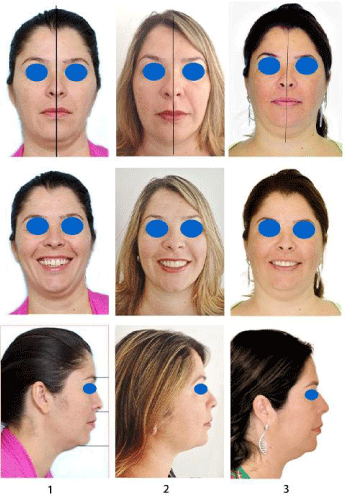
Figure 5: Evolution of the face. Column 1:initial patient photos. Column 2:
final, and Column 3: control after two years and nine months.
Discussion
Orthopedic misalignment (tilted occlusion and pelvis) was treated, eliminating the discrepancy between CR and MIC [10-13].
The period of occlusal splint use (24 hours), including during eating, cures neuromuscular disharmony and inflammatory TMJ, as viewed with resonance and CT scans; improves the bone structure of the mandibular head and its relationship with the articular eminence and cavity [12]; stabilizes the jaw in CR for the diagnosis of occlusion [10,12,13]; and improves the following symptoms: clicks, articular noises, locking, tinnitus, pain in the jaw, neck and shoulders, pain when opening the mouth, headache, ear pain, bruxism, tooth clenching [13].
Favorable responses to post splint occlusal therapy have been reported in cases of myofascial pain and temporomandibular dysfunction [10,13], and studies have found that occlusal splints associated with insoles have improved pain symptoms [11], as was the case in this study.
Conclusion
There is professional consensus on multiprofessional treatment for chronic pain. In the case of asymmetry, a tilted occlusion and pelvis (hidden) may be an irritating factor that contributes to the maintenance of pain, hence the importance of the approach used by bioesthetic dentistry (a deprogramming occlusa l splint and occlusion adjustment) and, in some cases, insole use. Stable pain control requires therapy, which will be evaluated in future studies.
Acknowledgement
Authors thanks to Dr. Rodrigo Barbosa Thomaz, Neurologist, and Marcus Vinicius Pereira Prada, Physiotherapist, for treatments given. Vânia Funaro, Librarian.
References
- Schiffman E, Ohrbach R, Truelove E, Look J, Anderson G, Goulet JP, et al. Diagnostic Criteria for Temporomandibular Disorders (DC/TMD) for Clinical and Research Applications: recommendations of the International RDC/TMD Consortium Network* and Orofacial Pain Special Interest Group. J Oral Facial Pain Headache. 2014; 28: 6-27.
- Marx P. Assessment of Whiplash and Cervical Spine Injury. Nervenarzt. 2011; 82:1525-1532.
- Castori M, Sperduti I, Celletti C, Camerota F, Grammatico P. Symptom and Joint Mobility Progression in the Joint Hypermobility Syndrome (Ehlers- Danlos Syndrome, Hypermobility Type). Clin Exp Rheumatol. 2011; 29: 998- 1005.
- Bricot B. Posturologia Clínica. São Paulo: CIES Brasil.2011.
- Gift AG. Visual Analogue Scales: Measurement of Subjective Phenomena. Nurs Res. 1989; 38: 286-288.
- Kroenke, K,Spitzer RL, Williams JBW, Löwe B. An Ultra-Brief Screening Scale for Anxiety and Depression: the PHQ-4. Psychosomatics. 2009; 50: 613-621.
- Von Korff M, Ormel J, Keefe FJ, Dworkin SF. Grading the Severity of Chronic Pain. Pain. 1992; 50: 133–149.
- Provenzano MM, Chilvarquer I, Fenyo-Pereira M. How Should the Articular Disk Position be Analyzed? J Oral Maxillofac Surg. 2012; 70: 1534-1539.
- Julsvoll EH, Vøllestad NK, Robinson HS. Validation of Clinical Tests for Patients WithLong-Lasting painful Temporomandibular disorders With Anterior Disc Displacement Without Reduction. Man Ther. 2016; 21: 109-119.
- Freeland TC. Occlusal Equilibration (Positive/Negative Coronoplasty/ and Selective Tooth Grinding. In: Girardot RA Jr, editor. Goal-Directed Orthodontics. Los Gatos (CA): Roth Williams International Society of Orthodontics. 2013; 551-559.
- Rothbart BA. Prescriptive Proprioceptive Insoles and Dental Orthotics Change the Frontal Plane Position of the Atlas (C1), Mastoid, Malar, Temporal, and Sphenoid Bones: a Preliminary Study. J Craniomandib Sleep Pract. 2013; 31: 300-308.
- Ikeda K. Imaging of the TMJ. In: TMJ 1ST Orthodontics. Concepts, Mechanics and Stability. Tokyo: Topnotch Kikaku Ltd. 2014; 39-45.
- Sletten WO, Taylor LP, Goodacre CJ, Dumont TD. The Effect of Specially Designed and Managed Occlusal Devices on Patient Symptoms and Pain: a Cohort Study. Gen Dent. 2015; 63: 46-52.